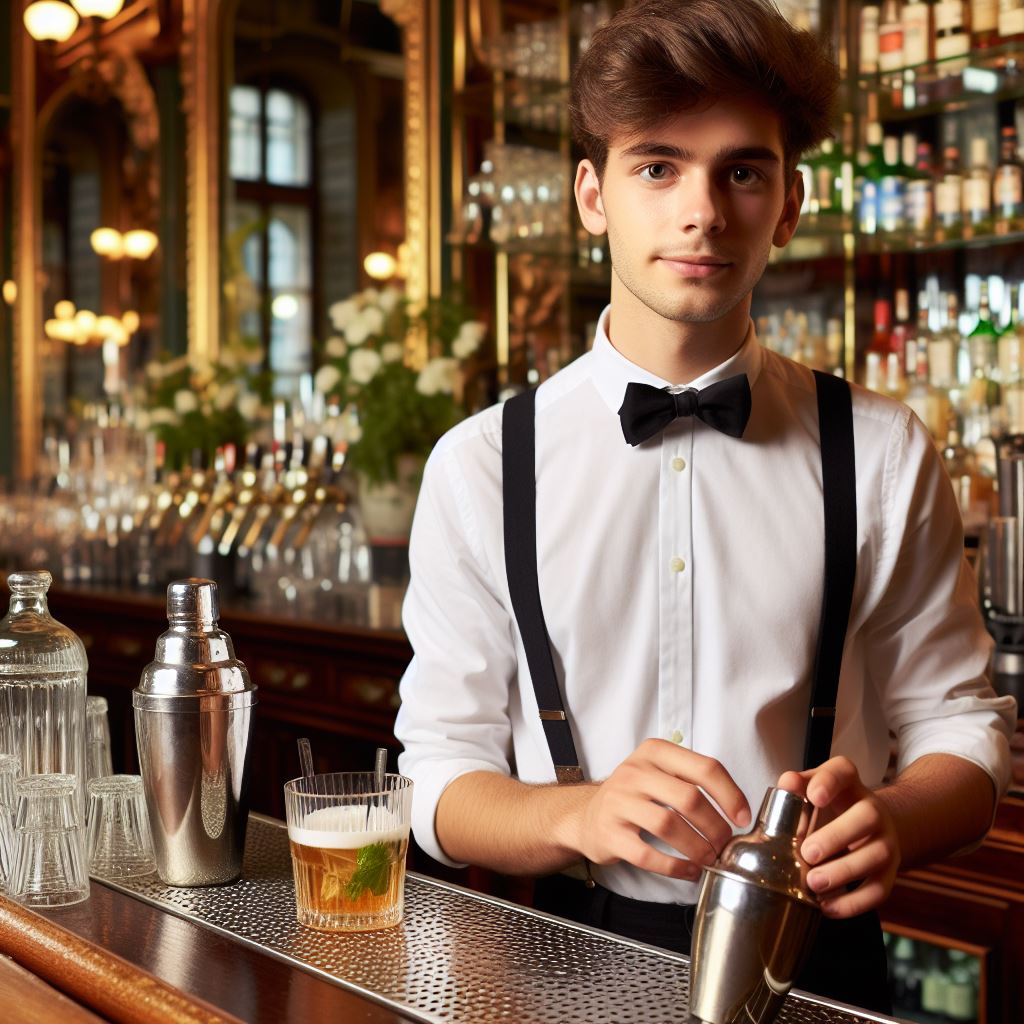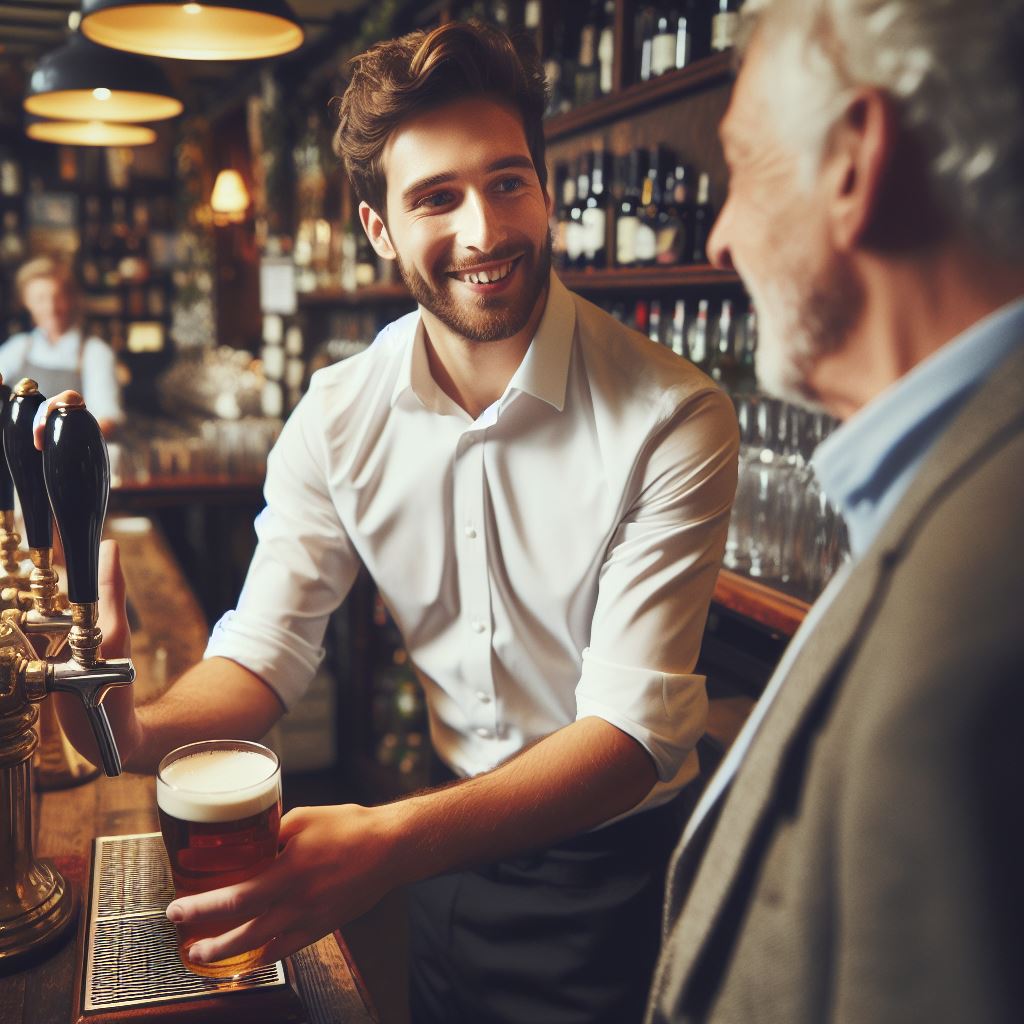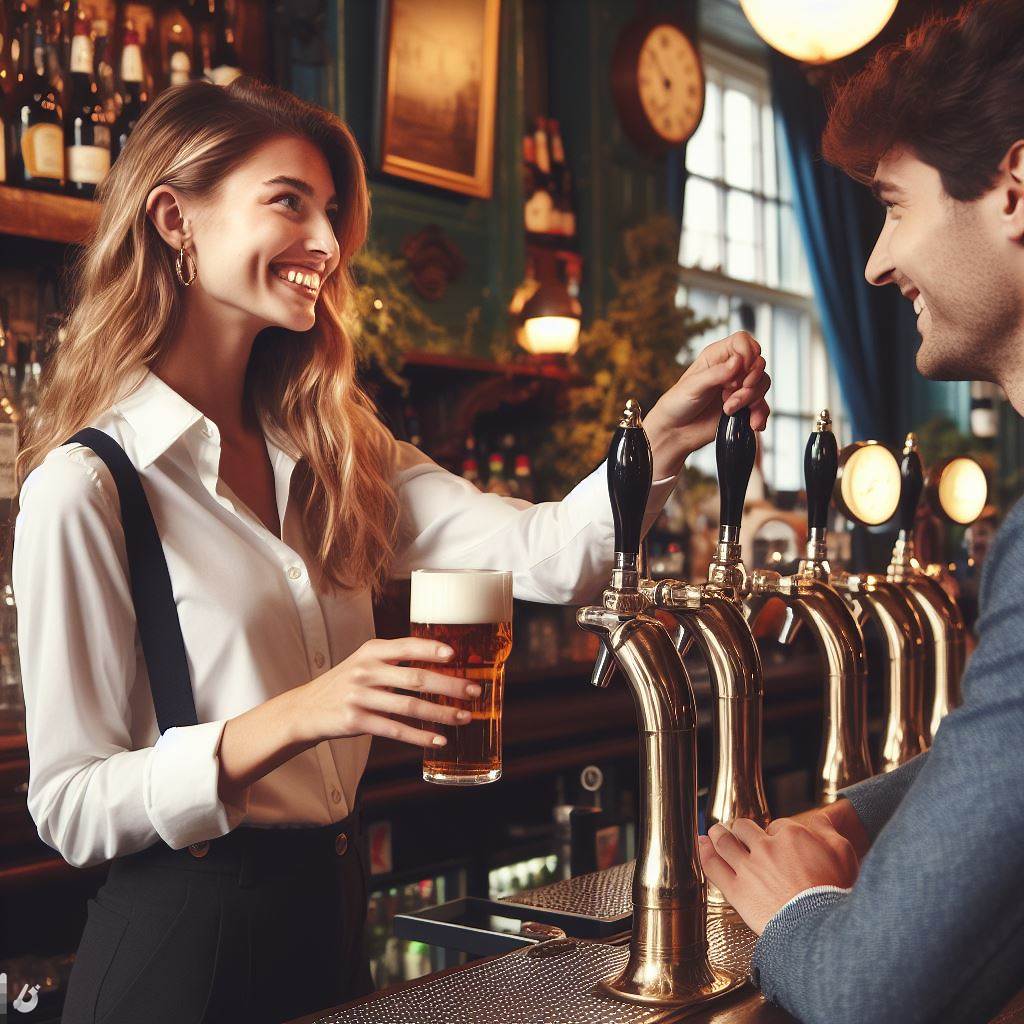Introduction
Health and safety in bars are of paramount importance. Bartenders, as frontline staff, play a vital role in ensuring the well-being of both themselves and their customers.
Therefore, it is crucial for them to have a solid understanding of the necessary precautions and procedures to ensure a safe workplace.
In this blog post, we will explore various aspects of health and safety in the UK bar industry.
From the proper handling of hazardous substances to managing crowds and preventing accidents, we will cover a range of topics aimed at equipping bartenders with the knowledge they need to create a safe environment.
Maintaining health and safety standards not only helps to prevent accidents and injuries but also builds trust with customers and enhances their overall experience.
By implementing effective practices, bartenders can ensure a hygienic and secure atmosphere, which promotes a positive reputation for the bar and boosts customer loyalty.
Throughout this blog section, we will delve into specific areas that bartenders should focus on, such as food safety, responsible alcohol service, fire safety, and first aid procedures.
By addressing these key topics, bartenders can confidently handle potential risks, respond appropriately to emergencies, and protect both themselves and others.
In the upcoming sections, we will provide valuable information, practical advice, and useful tips that bartenders can implement immediately to enhance safety and ensure compliance with regulations.
Let’s dive in and explore the world of health and safety in UK bars, empowering bartenders to create a secure environment for all.
The role of a bartender in ensuring health and safety
Importance of bartenders in maintaining a safe and healthy environment
Bartenders play a crucial role in ensuring the health and safety of customers and staff.
They are responsible for creating a comfortable and secure atmosphere within the bar.
By monitoring the behavior of patrons and addressing any potential risks or hazards, bartenders can prevent accidents and incidents.
They enforce rules and regulations, such as age restrictions, to maintain a safe environment.
Bartenders also have an essential role in preventing overconsumption and promoting responsible drinking.
Personalized UK Career Consulting
Receive tailored career guidance designed just for you. Get actionable steps and expert support to boost your career in 1-3 days. Take control of your career now.
Get StartedResponsibilities of bartenders in relation to health and safety regulations
Bartenders are expected to comply with health and safety regulations to protect customers and themselves.
They must ensure that the bar area is clean and free from any hazards.
This includes regular cleaning, disposing of waste properly, and maintaining proper hygiene protocols.
They must be knowledgeable about fire safety measures and emergency procedures.
Bartenders should have a clear understanding of how to handle accidents, injuries, or any medical emergencies that may occur.
Training and certifications for bartenders
In order to effectively fulfill their role, bartenders should undergo specific training and obtain relevant certifications.
Training programs cover topics such as alcohol awareness, responsible service, and health and safety guidelines.
It is essential for bartenders to understand the risks associated with alcohol consumption and techniques to handle difficult situations.
Certifications, such as the Personal License Holder qualification, are often required by law for bartenders.
These certifications ensure that bartenders have the necessary knowledge and skills to prioritize health and safety.
Read: The Art of Flair Bartending: UK Edition
Identifying and preventing hazards in bars
Bars can be exciting and lively places, but they can also pose various health and safety hazards to both employees and customers.
As a bartender, it is crucial to be aware of these hazards and take necessary steps to prevent accidents and injuries.
Common hazards in bar settings
One common hazard in bars is slips, trips, and falls. Liquids spilled on the floor, including drinks and ice, can make surfaces slippery and cause accidents.
Your Dream Job Starts with a Perfect CV
Get a tailored CV and cover letter that captures your unique strengths and stands out in your industry. Let us help you make an unforgettable first impression.
Get StartedBartenders should always be alert and promptly clean up spills to prevent slips and falls.
Another hazard to watch out for is the handling and storage of hazardous materials.
Bars often handle and store chemicals and cleaning agents, which can be dangerous if not properly managed.
Bartenders should receive training on how to handle and store these substances safely.
Fire and electrical safety is also a concern in bars. Bars often have many electrical appliances and wiring, increasing the risk of electrical fires.
Bartenders should ensure that electrical equipment is properly maintained and regularly inspected to prevent fire hazards.
Noise exposure is another hazard that can affect the health and safety of bar staff.
Working in a loud environment can lead to hearing problems and unnecessary stress.
Bar owners should take measures to minimize noise levels, such as installing sound-absorbing materials and providing employees with protective earplugs.
Strategies to prevent hazards
To prevent these hazards and promote a safe working environment, bar owners and staff should implement the following strategies:
- Regular inspection of bar premises: Regular inspections should be conducted to identify potential hazards and address them promptly. This includes checking for slippery surfaces, faulty electrical equipment, and storage of hazardous materials.
- Proper equipment maintenance: Bartenders should ensure that all equipment, including electrical appliances and tools, is regularly maintained and in good working condition. This helps prevent accidents related to equipment malfunction.
- Staff awareness and training programs: Bar staff should receive comprehensive training on health and safety procedures, including proper handling of hazardous materials, fire safety protocols, and how to prevent slips and falls. Developing a culture of awareness among the staff is crucial for maintaining a safe environment.
- Emergency preparedness and evacuation plans: Bars should have clear and well-communicated emergency preparedness plans in place. This includes having proper evacuation routes, designated meeting points, and training employees on how to respond to emergencies such as fires or medical incidents calmly and efficiently.
By identifying and preventing hazards in bars, bartenders can contribute to a safer and healthier workplace for both themselves and their customers.
Prioritizing health and safety not only reduces the risk of accidents but also enhances the overall experience for everyone in the bar.
Read: UK Bartender Guide: Essential Bar Tools and Uses
Safe practices for bartenders
Personal hygiene and cleanliness
Bartenders should maintain good personal hygiene by washing hands regularly, wearing clean uniforms, and keeping hair tied back.
Optimize Your LinkedIn for Success
Boost your LinkedIn profile with a professional bio, keyword-rich headline, and strategic recommendations that attract recruiters. Stand out from the crowd and get noticed.
Optimize NowProper handling and storage of ingredients
Bartenders must ensure that all ingredients are stored properly, at the correct temperature, and away from contaminants.
Responsible alcohol service
Bartenders should be knowledgeable about the effects of alcohol and adhere to responsible service practices, such as checking IDs and refusing service to intoxicated individuals.
Managing intoxicated or unruly customers
Bartenders should be trained in managing difficult situations, including recognizing signs of intoxication, diffusing conflicts, and knowing when to involve security or law enforcement.
First aid knowledge and response to minor injuries
Bartenders should have basic first aid knowledge and be prepared to respond to minor injuries such as cuts or burns that may occur in a fast-paced bar environment.
Read: Salary Insights: What UK Bartenders Really Earn

Health and safety regulations for UK bars
Overview of applicable regulations and legislation
- The health and safety of employees and customers in UK bars is governed by various regulations and legislation.
- The Health and Safety at Work Act 1974 is the primary legislation that sets out general duties and responsibilities for ensuring health and safety.
- Additionally, the Control of Substances Hazardous to Health (COSHH) Regulations 2002 apply to the handling of hazardous substances in bars.
- Furthermore, the Reporting of Injuries, Diseases and Dangerous Occurrences Regulations 2013 require the reporting of certain incidents in bars.
- The Regulatory Reform (Fire Safety) Order 2005 regulates fire safety measures in bars to protect both employees and patrons.
- Overall, these regulations and legislation aim to ensure a safe and healthy environment in UK bars.
Compliance requirements for bars and bartenders
- Bars and bartenders must comply with the applicable health and safety regulations and legislation.
- They should conduct regular risk assessments to identify potential hazards and implement necessary control measures.
- Bartenders should receive proper training on health and safety procedures, including manual handling and the use of protective equipment.
- Bars must provide a safe working environment for their employees, ensuring that necessary safety equipment is available and maintained.
- It is important for bars to have clear emergency procedures in place, including evacuation plans and first aid arrangements.
- Regular inspections and maintenance of equipment, such as fire extinguishers and electrical systems, are essential to ensure safety.
Penalties for non-compliance
- Non-compliance with health and safety regulations can result in severe penalties for bars and bartenders.
- Fines can be imposed depending on the severity of the breach, with higher penalties for serious or repeated offenses.
- Enforcement notices may be issued, requiring bars to take specific actions to rectify any breaches of health and safety regulations.
- In extreme cases, bars may face closure if they consistently fail to comply with health and safety requirements.
- Bartenders can also be held personally accountable for their actions and may face legal consequences for neglecting health and safety.
- It is important for bars and bartenders to prioritize compliance with health and safety regulations to avoid penalties and protect everyone involved.
In essence, understanding and complying with health and safety regulations is crucial for UK bars and bartenders.
By following the applicable regulations and legislation, bars can create a safe and healthy environment for their employees and customers.
Failure to comply can result in severe penalties, including fines, enforcement notices, and even closure of the establishment.
Therefore, it is essential for bars and bartenders to prioritize health and safety to ensure the well-being of everyone involved.
Read: Cocktail Recipes Every UK Bartender Should Know
Creating a Safety Culture in Bars
Importance of Promoting a Safety-First Mindset
- Prioritizing safety ensures the well-being of both staff and patrons.
- By instilling a safety-first mindset, bars can prevent accidents and minimize risks.
- Emphasizing the importance of safety creates a positive and responsible work environment.
- A safety-conscious culture reduces liability and protects the reputation of the bar.
Encouraging Active Involvement of All Staff Members
- Every staff member should be empowered to take an active role in promoting safety.
- Encourage staff to identify potential hazards and report them promptly.
- Providing safety training to all staff members ensures they are equipped with the necessary knowledge.
- Promote open communication to address safety concerns and implement improvements.
Regular Safety Meetings and Communication
- Conduct regular safety meetings to discuss safety protocols, procedures, and updates.
- Active communication ensures that staff members are aware of any changes or new safety measures.
- Involve staff in safety discussions to gather their inputs and encourage their ownership.
- Including risk assessments during safety meetings aids in mitigating potential hazards.
Recognizing and Rewarding Safe Behaviors
- Acknowledge and appreciate staff members who consistently adhere to safety guidelines.
- Publicly recognize individuals who take extra precautions to ensure the safety of others.
- Rewarding safe behaviors promotes a positive safety culture throughout the bar.
- Implement incentive programs to incentivize and reinforce safe practices among the staff.
Creating a safety culture in bars is essential to minimize risks, protect personnel, and maintain a positive reputation.
By promoting a safety-first mindset, bars can prevent accidents and establish a responsible work environment.
Encouraging active involvement of all staff members empowers them to identify and report potential hazards promptly.
Regular safety meetings and communication ensure that everyone is informed about safety protocols and any updates.
Recognizing and rewarding safe behaviors reinforces the importance of adhering to safety guidelines, fostering a positive safety culture.
Implementing these strategies will not only ensure the bar’s compliance with health and safety regulations but also create a safe and enjoyable experience for staff and patrons.
Uncover the Details: UK Event Planning Certifications
Conclusion
Throughout this section, we have explored the various aspects of health and safety in UK bars.
We covered essential health and safety guidelines for UK bars—prioritizing hygiene, proper equipment usage, and staff training.
It is crucial for bartenders to prioritize the well-being of both themselves and their customers.
Underscoring the critical role of health and safety, it safeguards patrons, staff, and establishments, fostering a responsible drinking culture.
Bartenders, commit to a proactive approach in integrating health and safety protocols. Your diligence ensures a secure and thriving bar environment.
Let us commit to implementing proper protocols and maintaining a safe and healthy environment for everyone in our bars.
[E-Book for Sale]
500 Cutting-Edge Tech Startup Ideas for 2024 & 2025: Innovate, Create, Dominate
$19.99 • 500 Tech Startup Ideas • 62 pages
You will get inspired with 500 innovative tech startup ideas for 2024 and 2025, complete with concise descriptions to help you kickstart your entrepreneurial journey in AI, Blockchain, IoT, Fintech, and AR/VR.




